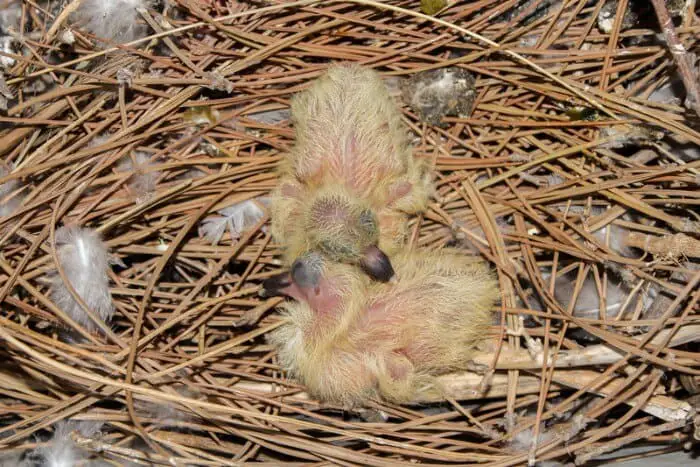Baby pigeons are usually ready to leave the nest almost a month after they have hatched.
The average time is between 25-29 days after they break out of their shells, although this can depend on which season they are hatched.

Pigeons born in the winter season tend to stay in the nest longer than those in autumn, spring or summer.
They can remain with their parents for up to 45 days.
Mating Cycle
A mating pair will start their breeding cycle a couple of weeks after they have built their nest.
The female usually lays two eggs.
Sometimes it can take up to over 40 hours between the first egg and second being laid.
It’s rare for female pigeons to lay three eggs.
Both the male and female take turns incubating the eggs, which takes around 18 days.

These squabs or squeakers, as they are called, don’t take the normal food that adult pigeons eat.
They are fed on ‘crop milk’ for the first few days. Crop milk is food that the parent birds have eaten and digested, which is then regurgitated in the form of a milky liquid.
This liquid can be produced by both male and female so that both of them will feed the hatchlings.
Also Read:
Do Pigeons Kill Their babies?
Nurturing Baby Pigeons
It is said nobody actually sees baby pigeons, only the adults.
That is because the squabs don’t emerge from the nest until they are fully-fledged young adults.
Until then, the parent birds keep them in the nest.

The reasons for this are to keep them warm, away from predators and well-fed as their feathers grow.
Both parents will help feed the young pigeons, taking turns to guard the nest and searching for food to bring back to the young ones.
Independence
By the time they are ready to leave the nest they should have the appearance of adult pigeons, with all their feathers grown in, have the approximate size of their parents and are ready to fly.
In fact, an observer may see the parents actively encouraging their young ones to leave the nest by pushing them.
It will take a young pigeon around another seven months before they reach full maturity and mate, to start the whole cycle all over again.

This article was written by our qualified veterinarian Cristina.
This is part of our commitment to providing you with the most trustworthy veterinary advice for your pigeons.
Sources:
